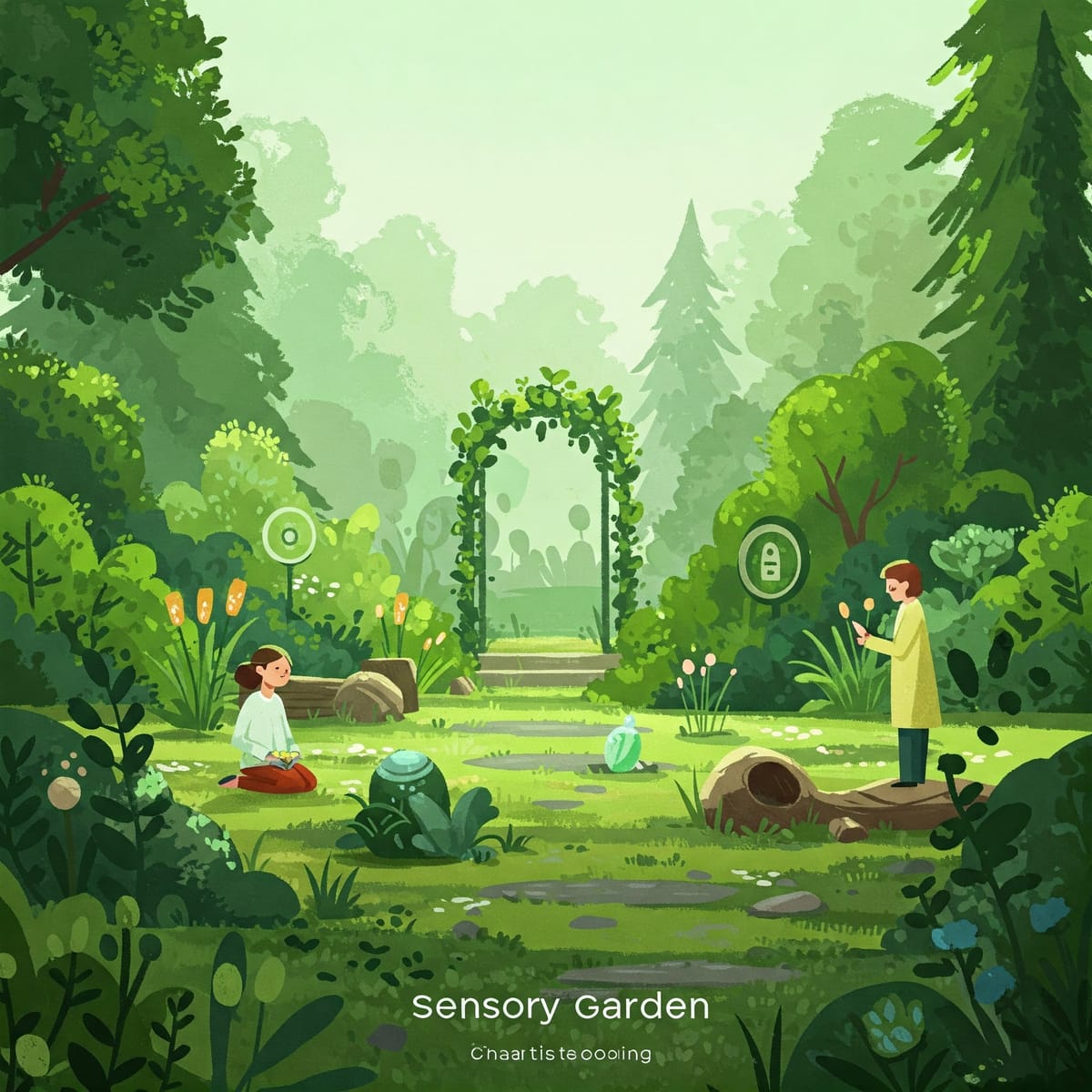The Therapeutic Power of Sensory Gardens: Design, Benefits, and Applications

TLDR
Sensory gardens are intentionally designed outdoor spaces that stimulate the five primary senses: sight, smell, sound, touch, and taste. They offer significant therapeutic benefits, including stress reduction, mood enhancement, cognitive improvement, and support for individuals with conditions like dementia, autism spectrum disorder, and anxiety. Careful horticultural design, accessibility considerations, and sustainable practices are crucial for creating effective and inclusive sensory gardens.
The Therapeutic Power of Sensory Gardens: Design, Benefits, and Applications
Introduction: The Essence of Sensory Gardens
Sensory gardens are more than just visually appealing landscapes; they are intentionally crafted environments designed to stimulate one or more of the five primary senses: sight, smell, sound, touch, and taste. These gardens prioritize creating a rich tapestry of sensory experiences that promote interaction and offer therapeutic or educational benefits. The core aim is to immerse visitors in the natural world through a holistic sensory experience.
The importance of sensory gardens has grown significantly, with increasing recognition of their therapeutic potential in various healthcare and well-being settings. These gardens serve as natural havens for individuals facing diverse challenges, including autism spectrum disorder, Alzheimer's disease, dementia, and anxiety disorders. Their adaptability makes them suitable for implementation in a range of environments, such as dementia care facilities, autism intervention programs, mental health rehabilitation centers, and physical therapy settings. Furthermore, sensory gardens are valuable tools for stress reduction, promoting mindfulness, and enhancing mental and emotional well-being.
This blog post delves into the creation and therapeutic benefits of sensory gardens, exploring their design principles, neurological effects, therapeutic applications, accessibility considerations, cultural context, practical creation and maintenance in Sydney, NSW, evidence-based outcomes, the role of specific sensory elements, safety measures, and sustainable practices.
The Art and Science of Horticultural Design
Effective sensory garden design involves a thoughtful integration of horticultural science and artistic principles to maximize sensory stimulation and therapeutic benefits.
Visual Stimulation: Color, Light, and Movement
Visual stimulation is key to a sensory garden's appeal. This is achieved through the strategic use of vibrant flowering plants, with careful selection to ensure continuous visual interest across all seasons. Color themes, such as dedicated "color corners" featuring specific palettes like calming blues or vibrant reds, can provide focused sensory experiences. Incorporating plants with colorful foliage and variegated leaves further enhances visual appeal. The strategic use of light and shade is also crucial, with consideration given to the garden's exposure to create areas of both sunlight and dappled shade. Introducing movement through ornamental grasses, wildflowers that attract pollinators, and vertical elements like trellises with climbing plants adds another layer of visual dynamism.
Tactile Experiences: Textures and Forms
Incorporating diverse textures is fundamental in sensory garden design, extending beyond plants to include pathways, sculptures, and seating. A wide array of tactile sensations can be achieved through plant selection, from the softness of lamb's ear to the roughness of tree bark. Varied pathway materials, such as smooth paving stones and rough gravel, can enhance the tactile experience and aid navigation for visually impaired individuals. Raised beds and vertical structures improve accessibility and encourage interaction. Choosing sturdy plants that can withstand touch is essential, and pairing contrasting textures, like soft foliage with spiky forms, can offer a richer tactile environment.
Olfactory Delights: Fragrance and Aromatherapy
Stimulating the sense of smell is a cornerstone of sensory garden design, achieved through fragrant plants like roses, lavender, jasmine, and aromatic herbs such as basil and mint. Planting these herbs near pathways maximizes olfactory encounters. Considering the placement of fragrant plants ensures they are easily accessible. Designers often select plants that offer scents across all seasons, and interactive elements like scent jars can provide concentrated olfactory experiences. The link between smell and memory is important, as specific scents can evoke positive memories and promote relaxation.
Gustatory Exploration: Incorporating Edible Plants Safely
Engaging the sense of taste involves carefully including edible plants like herbs, fruit trees, berry bushes, and edible flowers. Safety is paramount, requiring clear identification of edible plants and their separation from non-edible species. Creating a designated "taste trail" or herb tasting area allows visitors to safely sample flavors. Clear labeling and guidance on safe tasting practices are essential, and potential allergies must be considered.
Auditory Elements: Creating a Symphony of Sounds
A well-designed sensory garden incorporates auditory elements to create a calming and engaging soundscape. This can be achieved through plants that produce sounds in the wind, like ornamental grasses and bamboo, and features like wind chimes and water features. Water features, such as fountains, introduce the soothing sound of moving water and can mask unwanted noise. Attracting wildlife, particularly birds, and using materials like gravel on pathways can also contribute to the auditory experience.
Unlocking the Brain: Neurological Responses
Sensory gardens trigger a range of neural responses that can lead to alterations in brain chemistry and function. Spending time in a garden can lower blood pressure, decrease heart rate, and positively influence cortisol levels, indicating stress reduction. Direct contact with soil can increase serotonin levels, which is crucial for mood regulation, and promote a relaxed state. The experience of awe in nature can reduce self-focused thought, and physical activity in gardening can increase neurotrophic factors that promote neuroplasticity and brain health. Natural sounds can also alter brain connectivity and reduce the body's stress response.
A primary benefit of sensory gardens is their ability to reduce stress and anxiety and enhance feelings of well-being. Exposure to natural sounds can reduce stress hormones and increase positive emotions. Visual interaction with natural images can improve mood in individuals with depressive and anxiety disorders, and tactile experiences, like touching soft plants, can elicit relaxation and comfort.
Interaction with sensory garden elements can stimulate cognitive functions, including memory. For individuals with dementia, these gardens can evoke past memories, and green outdoor settings can reduce ADHD symptoms and improve attention span. Gardening activities necessitate cognitive tasks and can enhance patience, frustration tolerance, cognitive flexibility, and social skills.
The diverse sensory experiences in a sensory garden activate various interconnected brain regions, contributing to the overall therapeutic effect. Visual input activates areas like the prefrontal cortex and occipital lobe. Auditory stimuli are processed in the temporal cortex. Olfactory input directly projects to the amygdala, orbitofrontal cortex, and hippocampus. Tactile sensations are processed in the somatosensory cortex and influence emotional responses. Taste activates the insular cortex and orbitofrontal cortex. Aromatherapy, often facilitated by fragrant plants, can modulate mood, anxiety, and sleep patterns.
Sensory Gardens as Therapeutic Tools
Sensory gardens have diverse applications across various therapeutic settings, offering natural and accessible means to address a range of needs.
Dementia Care: Evoking Memories and Reducing Agitation
Sensory gardens are valuable therapeutic tools in dementia care, promoting physical activity, encouraging reminiscence, decreasing stress and anxiety, and stabilizing sleep-wake cycles. Familiar plant scents and visual cues can be particularly effective in evoking cherished memories. Regular engagement with sensory gardens can reduce agitation, improve mood, and enhance cognitive function in individuals with dementia. Olfactory stimulation plays a crucial role in improving memory in older adults with dementia.
Autism Spectrum Disorder Interventions
Sensory gardens offer a safe and controlled environment for individuals on the autism spectrum, facilitating sensory processing and integration. Thoughtful design that incorporates predictable and calming stimuli is essential to minimize sensory overload. These gardens can also support therapy sessions, providing a less overwhelming backdrop for practicing social interactions and developing communication skills. Careful consideration of tactile sensitivities is important, with a selection of textures that provide both stimulating and comforting experiences.
Mental Health Rehabilitation
Sensory gardens can significantly benefit mental health rehabilitation by offering a natural way to alleviate stress, reduce anxiety, and improve overall mood. Spending time in green spaces lowers stress-related hormones, and therapeutic gardens with contemplative features can induce positive changes in mood and brain activity in individuals experiencing depression. Visual interaction with natural environments has also demonstrated mood-enhancing effects in patients with depressive and anxiety disorders.
Physical Therapy
Gardening activities can improve physical strength, flexibility, coordination, stamina, and overall fitness. Sensory gardens encourage physical activity through walking and interaction with sensory elements, which can improve motor skills and coordination. Varied path surfaces and designated planting areas can provide engaging opportunities for physical rehabilitation. Raised garden beds offer accessible ways for individuals with limited mobility to participate in gardening.
Stress Reduction and Mindfulness Practices
Sensory gardens are powerful tools for cultivating mindfulness, encouraging individuals to focus on their sensory experiences and become more present. Engaging with a sensory garden can reduce stress and anxiety, and the sound of running water can promote relaxation. Mindfulness practices, facilitated by the serene environment, can induce neuroplasticity, improve emotional regulation, and enhance resilience to stress.
Accessibility and Universal Design
Creating truly therapeutic sensory gardens requires a commitment to accessibility and universal design principles. Pathways should be wide and non-slip to accommodate wheelchairs, and seating should be available at regular intervals. Raised planting beds and lowered viewpoints can improve access to plant life. Clear signage with large fonts and Braille is essential, and tactile pathways can aid navigation for visually impaired individuals. Designated quiet spaces with muted colors and gentle sensory input are important for individuals with sensory processing sensitivities.
Cultural and Historical Context
The concept of gardens as spaces for healing and sensory experience has deep roots in human history and holds cultural significance across societies. Gardens have long been recognized for their capacity to promote physical, mental, and spiritual well-being through sensory engagement.
Practical Considerations for Creating and Maintaining a Sensory Garden in Sydney, NSW
Creating and maintaining a thriving sensory garden in Sydney requires careful consideration of several practical aspects.
Climate-Appropriate Plant Selection
Choosing plants that are hardy and well-suited to Sydney's climate is essential. Low-maintenance and robust varieties, as well as plants with varied colors, heights, textures, and bloom times, are ideal. Touch-friendly and fragrant plants that thrive in Sydney should be prioritized.
Soil Management and Sustainable Irrigation
Understanding the specific soil requirements of chosen plants and implementing water-efficient irrigation techniques are crucial. Drip irrigation, soaker hoses, and rainwater harvesting systems can minimize water waste and enhance sustainability.
Natural Pest Control Strategies
Avoiding plants prone to pests requiring chemical pesticides is advisable. Natural pest control methods, such as encouraging beneficial insects and using organic pest control sprays, are preferred. Companion planting can also be an effective strategy.
Seasonal Considerations for Year-Round Sensory Engagement
Planning the sensory garden with plants that offer stimulation across all seasons is key. This includes selecting plants with visual interest, fragrances, and textures that persist throughout the year.
Evidence-Based Outcomes
Research demonstrates the quantifiable therapeutic benefits of sensory gardens, including improvements in mood, cognitive function, physical abilities, and social interactions. Studies have reported reduced agitation in individuals with dementia and faster recovery times in various therapeutic settings.
Enhancing the Experience: The Role of Specific Sensory Features
Specific sensory features can further enhance the therapeutic experience of sensory gardens.
Water Features
Water features like fountains and ponds add auditory and visual interest, creating a calming ambiance and promoting relaxation. The sound of flowing water can activate the parasympathetic nervous system, associated with rest and relaxation.
Wind Chimes
Wind chimes introduce auditory interest and a subtle musicality, enhancing the garden's sensory richness and contributing to a peaceful atmosphere.
Edible Plants
Edible plants engage the sense of taste and provide a unique, interactive, and educational element, potentially evoking positive memories.
Safety Considerations
Prioritizing safety is paramount. All plants should be non-toxic and free from hazards. Clear pathways, non-slip surfaces, and secure installation of features are essential. Adequate comfort through seating, shade structures, and shelters is also important.
Sustainable Practices
Incorporating sustainable gardening practices aligns with environmental responsibility and enhances the therapeutic experience. Rainwater harvesting, composting, and prioritizing native plants are beneficial. Avoiding pesticides is crucial for maintaining a healthy environment for people and wildlife.
Conclusion: The Transformative Potential of Sensory Gardens
Sensory gardens offer a multifaceted approach to promoting health and well-being, combining horticultural design and neuroscience. Their design principles, neurological benefits, and diverse applications demonstrate their transformative potential. Emphasizing accessibility, safety, and sustainability ensures these gardens can be enjoyed by everyone and contribute to a healthier, more connected world.




